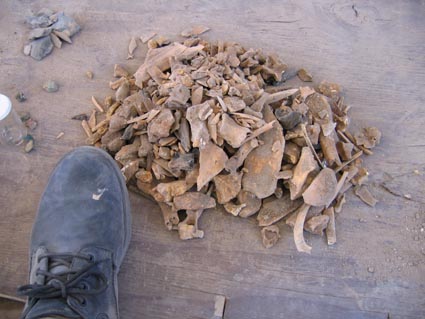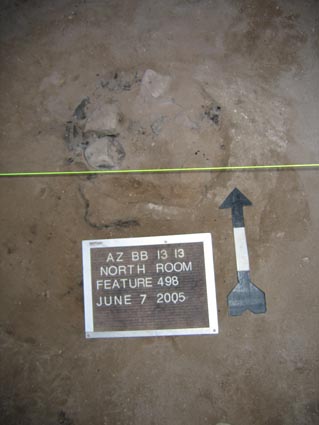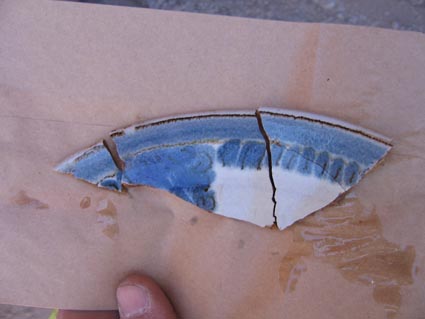Tuesday, June 07, 2005
Dig, Day 13. As things wind up we are hurrying to get finished. In the north room we are going down in the west half of the room, still excavating layers of Spanish period trash. Lots of animal bones- mostly sheep, with some cattle and chicken.

Animal bones from one layer of dirt.
We collect samples of dirt to take back to the laboratory. There we will dump them into a flotation tank and the charred plant remains float to the top and are collected on a cloth screen. After they are dried the samples are boxed and later some are selected for analysis. Our ethnobotanist looks at the charred remains and is able to identify what kinds of plants and wood were used by the people living in Tucson. Wheat and corn are common, sometimes we also find beans and squash. One of the pits that we excavated in the first week had peach pits and watermelon seeds.
Also in the north room, we uncovered a small cooking hearth. It was filled with charcoal and had a number of rocks sticking out of it. The rocks were used to set ceramic pota onto, keeping the base of the pot off of the embers. The people living in Tucson used to cook outdoors during the summer, because it was just too hot to cook inside. We collected most of the charcoal and ash from the hearth for flotation.

Hearth.
Most of the majolica we find has been smashed into little, tiny pieces- the result of being walked on by people and animals in the fort. Today we finally found a nice large fragment that gives a slightly better sense of the design. If you look carefully you can see that the blue splotch in the center is actually the face of a cherub, with small dots for eyes and an upturned nose.

San Elizario Blue on White plate.
At home this afternoon I scrubbed the dirt off. Somehow I always miss some spots- inside my elbow, inside my ear, on top of one of my toes. I think it is because I come home so tired it is hard to concentrate.
Newer› ‹Older

Animal bones from one layer of dirt.
We collect samples of dirt to take back to the laboratory. There we will dump them into a flotation tank and the charred plant remains float to the top and are collected on a cloth screen. After they are dried the samples are boxed and later some are selected for analysis. Our ethnobotanist looks at the charred remains and is able to identify what kinds of plants and wood were used by the people living in Tucson. Wheat and corn are common, sometimes we also find beans and squash. One of the pits that we excavated in the first week had peach pits and watermelon seeds.
Also in the north room, we uncovered a small cooking hearth. It was filled with charcoal and had a number of rocks sticking out of it. The rocks were used to set ceramic pota onto, keeping the base of the pot off of the embers. The people living in Tucson used to cook outdoors during the summer, because it was just too hot to cook inside. We collected most of the charcoal and ash from the hearth for flotation.

Hearth.
Most of the majolica we find has been smashed into little, tiny pieces- the result of being walked on by people and animals in the fort. Today we finally found a nice large fragment that gives a slightly better sense of the design. If you look carefully you can see that the blue splotch in the center is actually the face of a cherub, with small dots for eyes and an upturned nose.

San Elizario Blue on White plate.
At home this afternoon I scrubbed the dirt off. Somehow I always miss some spots- inside my elbow, inside my ear, on top of one of my toes. I think it is because I come home so tired it is hard to concentrate.
